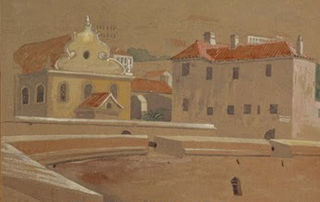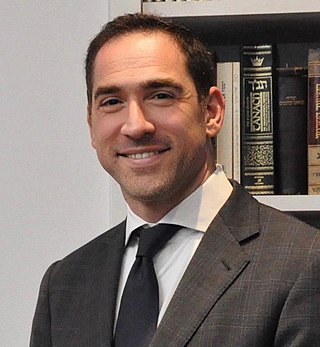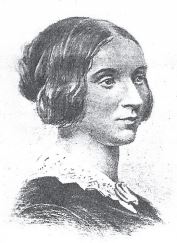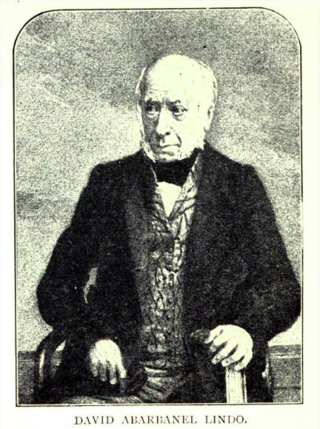
The Ohel Leah Synagogue and its next-door neighbors, the Jewish Recreation Club and the Jewish Community Centre, have formed the center of Jewish social and religious life in Hong Kong for over a century. Originally the community was mostly Baghdadi and the synagogue was under the superintendence of the Haham of the Spanish and Portuguese Congregation of London: it is now fully independent and has members from across the Jewish diaspora.
Spanish and Portuguese Jews, also called Western Sephardim, Iberian Jews, or Peninsular Jews, are a distinctive sub-group of Sephardic Jews who are largely descended from Jews who lived as New Christians in the Iberian Peninsula during the few centuries following the forced expulsion of unconverted Jews from Spain in 1492 and from Portugal in 1497. They should therefore be distinguished both from the descendants of those expelled in 1492 and from the present-day Jewish communities of Spain and Portugal.

Bevis Marks Synagogue, officially Qahal Kadosh Sha'ar ha-Shamayim, is an Orthodox Jewish congregation and synagogue, located off Bevis Marks, Aldgate, in the City of London, England, in the United Kingdom. The congregation is affiliated to London's historic Spanish and Portuguese Jewish community and worships in the Sephardic rite.

Reform Judaism, formally the Movement for Reform Judaism (MRJ) and known as Reform Synagogues of Great Britain until 2005, is one of the two World Union for Progressive Judaism–affiliated denominations in the United Kingdom. Reform is relatively traditional in comparison with its smaller counterpart, Liberal Judaism, though it does not regard Jewish law as binding. As of 2010, it was the second-largest Jewish religious group in the United Kingdom, with 19.4% of synagogue-member households. On 17 April 2023, Reform Judaism and Liberal Judaism announced their intention to merge as one single unified progressive Jewish movement. The new movement, which may be called Progressive Judaism, will represent about 30% of British Jewry who are affiliated to synagogues.

The West London Synagogue, abbreviated WLS, and fully the West London Synagogue of British Jews is a Reform Jewish congregation and synagogue, located near Marble Arch, at 34 Upper Berkeley Street, in the City of Westminster, in Central London, England, in the United Kingdom.

Shemtob Gaguin(e) (5 September 1884 – 30 July 1953) was a British Sephardic rabbi and scion of a famous Moroccan rabbinical dynasty which emigrated to Palestine from Spain at the time of the Inquisition.

David de Aaron de Sola or David Aaron de Sola (1796–1860) was a rabbi and author, born in Amsterdam, the son of Aaron de Sola.

Henry Pereira Mendes, was an American rabbi who was born in Birmingham, England and died in New York City. He was also known as Haim Pereira Mendes.

Raphael Meldola was a Rabbi who served in the United Kingdom of Great Britain and Ireland. Born in Livorno, he died in London.
Rabbi Benjamin Artom (1835–1879) was the Haham of the Spanish and Portuguese Jews of Great Britain. He was born in Asti, Piedmont, in the Kingdom of Sardinia.

Solomon Gaon (1912–1994) was Sephardic Rabbi and Hakham of the Spanish and Portuguese Jews of the British Commonwealth.

Golders Green Jewish Cemetery, usually known as Hoop Lane Jewish Cemetery, is a Jewish cemetery in Golders Green, London NW11. It is maintained by a joint burial committee representing members of the West London Synagogue and the S&P Sephardi Community.

The four active synagogues of Gibraltar are colloquially known as the Great Synagogue, the Little Synagogue, the Flemish Synagogue, and the Abudarham Synagogue. The first synagogue established after the 1717 expulsion of Jews from Gibraltar, the Great Synagogue, was built on what is now known as Engineer Lane, and remains Gibraltar's principal synagogue. The Little Synagogue, founded in 1759 in Irish Town, was the result of the desire of Moroccan Jews for a less formal service. The lavish Flemish Synagogue was built at the turn of the nineteenth century on Line Wall Road, due to the request of some congregants for a return to more formal, Dutch customs. The last synagogue to be established in what is now the British overseas territory of Gibraltar, the Abudarham Synagogue, was founded in 1820 on Parliament Lane by recent Moroccan immigrants.

Joseph Dweck is an American rabbi and hazzan, who serves as Senior Rabbi of the Spanish and Portuguese Jewish community of the United Kingdom.

The Saatchi Synagogue, also called The Saatchi Shul, is an Orthodox Jewish congregation that worships from a synagogue located at 7/41 Grove End Road, in the City of Westminster, Central London, England, in the United Kingdom. The congregation worships in the Ashkenazi rite.

The Ohel Rachel Synagogue is a Sephardi synagogue in Shanghai, China. Built by Sir Jacob Elias Sassoon in memory of his wife Rachel, it was completed in 1920 and consecrated in 1921. Ohel Rachel is the largest synagogue in the Far East, and one of the only two still standing in Shanghai. Repurposed first under the Japanese occupation during World War II and again following the Communist conquest of Shanghai in 1949, the synagogue has been a protected architectural landmark of the city since 1994. It was reopened for some Jewish holidays from 1999 and briefly held more regular Shabbat services as part of the 2010 Shanghai Expo.
Judith Lady Montefiore College is a Jewish theological seminary founded in 1869 by Sir Moses Montefiore in memory of his late wife, Lady Judith Montefiore, at Ramsgate, Kent. Though closed in 1985, the College re-opened in London in 2005.

Charlotte [Simcha/Schönche] Montefiore was an Anglo-Jewish author and educational philanthropist.
Abraham Levy was an English Orthodox rabbi, theologian, and author. He served as spiritual head of the Spanish and Portuguese Jewish community in Britain from 1962 to 2012, and was a founding member of Naima Jewish Preparatory School. Levy was appointed an Officer of the Order of the British Empire (OBE) for services on inter-faith co-operation in the 2004 New Year Honours.

David Lindo (1772–1852) was an English Sephardi communal worker and elder of Bevis Marks Synagogue.





















